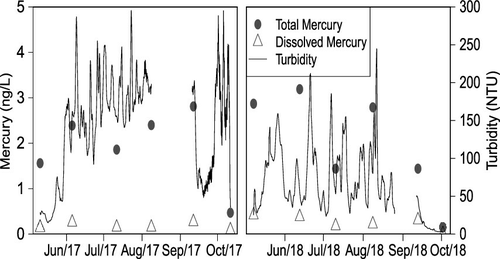当前位置:
X-MOL 学术
›
ACS Earth Space Chem.
›
论文详情
Our official English website, www.x-mol.net, welcomes your feedback! (Note: you will need to create a separate account there.)
Quantifying Meltwater Sources and Contaminant Fluxes from the Athabasca Glacier, Canada
ACS Earth and Space Chemistry ( IF 3.4 ) Pub Date : 2020-12-15 , DOI: 10.1021/acsearthspacechem.0c00256 Kasia J. Staniszewska 1 , Colin A. Cooke 1, 2 , Alberto V. Reyes 1
ACS Earth and Space Chemistry ( IF 3.4 ) Pub Date : 2020-12-15 , DOI: 10.1021/acsearthspacechem.0c00256 Kasia J. Staniszewska 1 , Colin A. Cooke 1, 2 , Alberto V. Reyes 1
Affiliation

|
Glaciers are retreating across the Canadian Rocky Mountains. As this ice volume is lost, trace elements, nutrients, and other contaminants, accumulated from millennia of atmospheric deposition, are subject to release in glacier meltwater with uncertain consequences for downstream water quality. We monitored and modeled meltwater chemistry at a high temporal resolution using a combination of grab sampling and sondes at the mouth of proglacial Sunwapta River, which drains the Athabasca Glacier in the Canadian Rocky Mountains. Two chemically and temporally distinct sources to melt were distinguished by principal component analysis: a component with a long subglacial residence time characterized by dissolved carbonate-associated elements, and a supra- and englacial component with short subglacial residence time, which contained potential legacy trace elements at low total concentrations and predominantly in a particulate form (total mercury, <3.2 ng/L; total lead, arsenic, and chromium, <2.0 μg/L) and legacy nutrients at moderate concentrations (nitrogen, <0.22 mg/L; phosphorus, <0.03 mg/L). Trace element fluxes and yields were modeled by pairing grab sampling results with correlated high-frequency conductivity or turbidity. Mercury yield (3.2 g/year/km2) was comparable to or lower than yields from other glacial meltwater streams globally. Long-term discharge data suggests that future contaminant yields will increase until peak water is reached, but at present, glacial meltwater does not significantly augment downstream nutrient and trace element contaminant budgets.
中文翻译:

量化来自加拿大阿萨巴斯卡冰川的融水水源和污染物通量
冰川正在穿越加拿大落基山脉。随着冰量的流失,几千年的大气沉积物中积累的痕量元素,养分和其他污染物会释放到冰川融水中,对下游水质的影响不确定。我们使用抓取采样和探空仪在高冰川时间的Sunwapta河口(结合了加拿大落基山脉的阿萨巴斯卡冰川流失)的高分辨率下对融化水化学进行监测和建模。主要成分分析可区分出两种化学上和时间上不同的熔融源:冰川下停留时间长的组分(以溶解的碳酸盐相关元素为特征),冰川上和冰期组分的冰川下停留时间短。含有潜在的残留微量元素,总浓度较低,且主要为颗粒状(总汞,<3.2 ng / L;铅,砷和铬的总含量,<2.0μg/ L)和中等浓度的遗留营养物(氮,< 0.22 mg / L;磷,<0.03 mg / L)。通过将抓取采样结果与相关的高频电导率或浊度配对来对痕量元素通量和产量建模。汞产量(3.2克/年/公里2)与全球其他冰川融水流的产量相当或更低。长期排放数据表明,直到达到峰值水位,未来的污染物产量将增加,但是目前,冰川融水并未显着增加下游养分和微量元素污染物的预算。
更新日期:2021-01-21
中文翻译:

量化来自加拿大阿萨巴斯卡冰川的融水水源和污染物通量
冰川正在穿越加拿大落基山脉。随着冰量的流失,几千年的大气沉积物中积累的痕量元素,养分和其他污染物会释放到冰川融水中,对下游水质的影响不确定。我们使用抓取采样和探空仪在高冰川时间的Sunwapta河口(结合了加拿大落基山脉的阿萨巴斯卡冰川流失)的高分辨率下对融化水化学进行监测和建模。主要成分分析可区分出两种化学上和时间上不同的熔融源:冰川下停留时间长的组分(以溶解的碳酸盐相关元素为特征),冰川上和冰期组分的冰川下停留时间短。含有潜在的残留微量元素,总浓度较低,且主要为颗粒状(总汞,<3.2 ng / L;铅,砷和铬的总含量,<2.0μg/ L)和中等浓度的遗留营养物(氮,< 0.22 mg / L;磷,<0.03 mg / L)。通过将抓取采样结果与相关的高频电导率或浊度配对来对痕量元素通量和产量建模。汞产量(3.2克/年/公里2)与全球其他冰川融水流的产量相当或更低。长期排放数据表明,直到达到峰值水位,未来的污染物产量将增加,但是目前,冰川融水并未显着增加下游养分和微量元素污染物的预算。


























 京公网安备 11010802027423号
京公网安备 11010802027423号